|
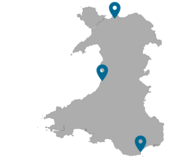
Thanks to all who responded to our recent survey to register your interest for flood volunteer network events.
The most popular locations were:
- Conwy
- Aberystwyth
- Cardiff
We have started planning the events for September or October and will share more information as soon possible so that you can save the date.
Don’t worry if you didn’t register your interest yet, there will be another opportunity to sign up to an event near you soon.
|
|
|
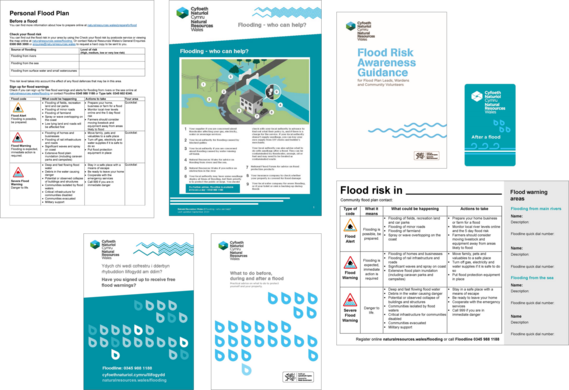 Our advice and guidance is available in hard copy that you can use and share with others.
You can request:
- paper copies to be sent directly to you
- multiple copies if you want to share with others
- alternative format, large print, or other languages
You can view and download digital versions and request copies to be sent to you by completing this short form, or you can call General Enquires on 0300 065 3000 (Monday – Friday, 9am – 5pm).
|
|
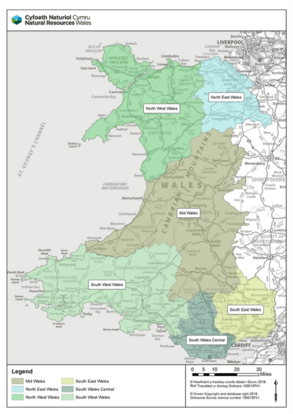
We are currently consulting on our Flood Risk Management Plan (FRMP) which shares our priorities and actions in managing the risk of flooding in Wales.
We want feedback from the communities that are at risk of flooding to help shape and finalise the plan ahead of publication later in 2023.
The FRMP provides information on the scale of flood risk from main rivers, reservoirs and the sea in the present day, as well as the future flood risk.
You can have your say on the national section of the plan, as well as the plan for your local area. The six local sections mirror the operational areas within NRW and shown on the map. These operational areas match to groupings of the Unitary Authorities in Wales. Your local section provides more detail about what is happening in the communities you live and work in, as well as what we’re planning to do over the next six years.
The online consultation is open until 24 May 2023.
Please visit Flood Risk Management Plan for Wales to read the plans and respond to the consultation.
|
|
|
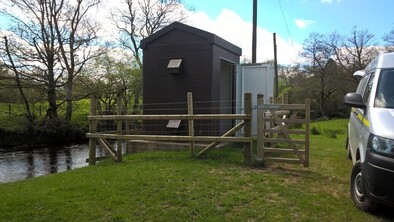
Sabrina Lee from BBC Wales News' weather team spent time with our hydrometry and flood forecasting teams to find out how river level and rainfall data we collect in the field plays a crucial role in warning and informing the public.
Our work to monitor river and coastal activity continues year round, not only when a storm is forecast. We showed Sabrina the range of tools we use which ranges from the traditional river level gauge, which looks like a huge ruler, to cutting edge technology like mini remote control boats and drones.
Find out more in this BBC News article and check your local river level, rainfall and sea data.
|
|
|
Making changes to a river channel or banks can increase the risk of flooding and cause environmental harm.
If someone wants to make changes to a river channel or banks, they need to check with the relevant authority first. This is to ensure they have the relevant permission, thereby preventing any adverse impacts to flood risk and the environment.
Every year, NRW receives many reports of work undertaken to rivers without permission. This includes:
- dredging, moving any material from the bed and banks of a river
- channel straightening or removing bends from a river, changing the natural meanders
- placement of new bank protection usually involving concrete or stone
- removal or modification of dry gravel banks, known as gravel shoals
- culverting, putting a watercourse within an enclosed pipe
Example of dredging and straightening
Example of inappropriate bank protection
Example of gravel removal
Example of an inappropriate culvert
These types of activities need approval as they can increase energy within a river and could increase flood risk at the location or elsewhere in the catchment. For example, they could:
- cause a river to flow much faster. When this happens, the water is more powerful and increases erosion of riverbanks and scouring of the riverbed. This could result in riverbanks collapsing and structures such as bridges suffering damage
- cause channel deepening and disconnect the river from its natural floodplain where water should be naturally be spilled and then stored to decrease flood risk to towns or villages downstream
- shorten the travel time of a flood, which can increase the flood risk for communities downstream
- narrow a river channel by containing it in a culvert or engineered banks. This can reduce the amount of water the river can hold and further increases the speed that the river flows by smoothing the channel too. This causes a river to flow much faster, eroding the bed and banks, shortening flood travel time and can increase flood risk
- remove sediment from a river channel increasing the energy (as the river can no longer use its energy moving the sediment, plus smoothening the channel) and causing water to flow much faster eroding the riverbed and banks, but also, it deepens the channel and disconnects the river from its natural floodplain where water should be naturally stored to decrease flood risk to town/villages downstream
Unauthorised physical modifications to a river could cause lasting or permanent damage to the natural environment.
Report the incident to us
You can report any incidents to us. Please do not approach the site or landowner yourself.
We would like to be notified of incidents in any river or stream, regardless of the location or size of the watercourse. Whether the works are ongoing or appear to have finished. Please provide as much information as you can including:
- the time
- location
- type and duration of the works
- if the work is still ongoing
- photos and videos are very helpful if it’s possible to take them from a safe location
Call our incident hotline on 0300 065 3000 or report the incident online naturalresources.wales/ReportIt. You can report it to us anonymously if you wish.
All reports of alteration or damage to rivers are passed to the local Environment Team for investigation. If the works are ongoing, we will respond with high priority and may stop the works if necessary. For works that are no longer ongoing, we will investigate as soon as practicable. If the works are found to be illegal, we can serve legal notices to the landowners to stop the works and undertake restoration work.
|
|
Fact: NRW can enforce against harmful alterations to rivers (hydromorphological harm)
Where physical modifications to any natural river or stream is undertaken without required permissions and due diligence, NRW may issue legal Notices to stop the work and, if necessary, require the river to be restored. We also have the option to prosecute and fine those undertaking the work.
If you are planning any works to a river, contact us for advice, and check the advice and information on our website about owning a watercourse.
Email enquiries@naturalresources.wales
Call 0300 065 3000 (Mon-Fri, 9am-5pm)
Read more about our role in this article on NRW crackdown on illegal gravel removal and modification works to rivers.
Fiction: Dredging rivers is a sure-fire way to reduce flooding
Dredging may not necessarily increase the capability of the watercourse to convey flows or reduce flood risk. It is also potentially environmentally damaging and may be in breach of environmental legislation without necessary mitigation measures in place.
Dredging is the removal of any material, like silt, sand or gravel, from the bed and banks of a river. Deepening and widening watercourses beyond their natural state.
The bed material (gravel, sand etc) in a river does not stay in one place, it is picked up and moved down the river during high flows much like a conveyor belt. Material is transported during high flows, and then deposited again as the energy of the flow recedes. At the point where a river bursts its banks, the energy of the flow within the channel starts to drop and bed material gets deposited once more. Removing bed material from a river interferes with the natural bed load balance. This causes the river to have excess energy which then results in erosion and can actually increase flood risk downstream.
Dredged rivers will naturally accumulate sediments as the river returns to its natural equilibrium. In doing so this can create unsustainable management requirements.
Dredging can be more effective in some locations than in others. We therefore make decisions on the best way to tackle any increased flood risk on a site-specific basis using specialist knowledge and evidence of how each river might respond to sediment removal, to ensure the most efficient use of resources. New knowledge and evidence could result in us no longer dredging and de-shoaling locations where we have done previously.
|
|
|
Below are messages provided on behalf of others, which may be of interest to you.
The Met Office
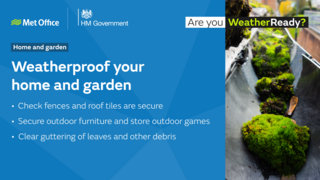
Time to get #WeatherReady for the summer months
As far as the weather goes, 2023 has started off with a cold spell, Wales's driest February since 1993 and one of the top ten wettest Marches on record. As the year progresses, it's certain that we will have more changeable conditions including the possibility of heavy summer rainfall which the latest climate science tells us is likely to get more extreme and more frequent.
As always, there are plenty of things we can all do to prepare ahead of summer weather – whatever it brings - from rain to sunshine.
Last year’s record-breaking heatwave means we all need to consider how we can keep ourselves, our families, and neighbours safe and well when things hot up. Making sure we cover up – wearing hats and protecting our skin with sunscreen and/or loose-fitting clothing is advisable. And when it’s really hot, keeping our homes cool by shutting curtains and – in extreme heat – windows is another good tip.
When it comes to heavy rain particularly when the ground is very dry and can’t absorb it, flooding and flowing water can cause damage to properties or businesses and difficult travelling conditions. It's important to keep an eye on the forecast and take action when heavy rain is forecast. This could be simply checking gutters and drains are clear or preparing a flood kit to help you cope in the event of flooding to your home and business.
Summer downpours can be intense and happen very quickly, with little if any warning. A thunderstorm can bring heavy rain and localised flooding to one area, but down the road you could still be enjoying the sun and see no flooding.
WeatherReady brings together expert advice from carefully selected partner organisations to help people prepare for and respond to the weather, so they not only stay safe, but are able to make the most of it. A wide range of advice articles can be found on the Met Office website, including top tips and advice on flood preparedness in collaboration with our partners around the UK.
Check NRW’s website naturalresources.wales/flooding for information and advice about flooding in Wales.
Find out more about what you can do to get yourself ready for any type of weather or join the conversation on social media using #WeatherReady.
|
|
|
- What would you like to see in future issues of this newsletter?
- Is there something you’d like to know more about?
- Would you be willing to share your experiences of flooding or as a community volunteer?
- Get in touch if you missed any of our previous issues, and we can share them with you.
|
|
|
You can choose which language you’d like to receive our newsletter in. Click ‘Manage your subscription’ at the end of the newsletter, and you can choose between English, Welsh or both languages. If you haven’t chosen your preferred language, we will send you both versions.
NRW is not responsible for the content of other sites. We are providing this as a signpost to information, and not as a promotion of other organisations or companies. We believe the advice that they are sharing is helpful to everyone. Links to external sites may only have information available in English.
Gallwch ddewis ym mha iaith yr hoffech chi dderbyn ein cylchlythyr. Cliciwch ‘Manage your subscription’ ar ddiwedd y cylchlythyr, a gallwch ddewis Cymraeg, Saesneg neu’r ddwy iaith. Os nad ydych chi wedi dewis iaith, byddwn yn anfon y ddwy fersiwn atoch.
Nid yw CNC yn gyfrifol am gynnwys gwefannau eraill. Rydym yn darparu hyn fel dull cyfeirio at wybodaeth, ac nid er mwyn hyrwyddo sefydliadau neu gwmnïau eraill. Credwn fod y cyngor y maent yn ei rannu yn ddefnyddiol i bawb. Efallai mai gwybodaeth yn Saesneg yn unig fydd ar gael mewn safleoedd allanol.
|
|
|
|
|